Soaking in the Colors of Zamboanga

At Zamboanga International Airport
“Uric acid, you mean?” I ask. She nods as she continues to knead out the “lamig” -- “cold spots” or small lumps in the body that Pinoy masseuses and manghihilot (healers) say are the physical manifestations of illness and discomfort. My body and face contort in various expressions of agony, and I’m sure there’s amusing footage on CCTV. Notwithstanding the sudden jolts of pain whenever she targets certain pressure points, the massage is good and relaxing overall. I signed up for only 30 minutes to while away the time at the airport, but I ask for 30 more when the time is up.
A healing foot rub
That was inside the Zamboanga International Airport on March 2, 2024, where I arrived early for my late afternoon flight back to Manila. The massage area is located in an obscure corner near one of the departure gates, only partially covered by a standing wooden board. The masseuse, Nur-Iana, is a Tausug, Islamized indigenous people who originally inhabited the Sulu archipelago – the southern tip of the Philippines. She lives near the Caragasan beach in Maasin, Zamboanga, and takes the habal-habal (motorcycle taxi) every day for her job at the airport. She was born and lives near the sea but did not learn how to swim. She hardly left their house growing up, on account of her disability. Her brothers, however, easily became accustomed to sea life and made a living out of planting seaweeds to make agar-agar. Meanwhile, Nur-Iana learned her craft through the Area Vocational Rehabilitation Center of the Department of Social Welfare and Development. I can say with certainty that she learned well.
It was just a short, two-day trip to Zamboanga, but I realize one can pack so much in with a little planning and a lot of curiosity. I flew there early morning of March 1, 2024, with work colleagues for a major event: the inauguration of the freshly minted building of the Commission on Human Rights-Region Nine (CHR IX). The building was funded by the European Union (EU) and the Agency for International Development Cooperation (AECID) of Spain through the project GOJUST II – The Human Rights Component (GOJUST II-HR). The event was scheduled at 1:30 p.m., thus we still had the whole morning to kill.
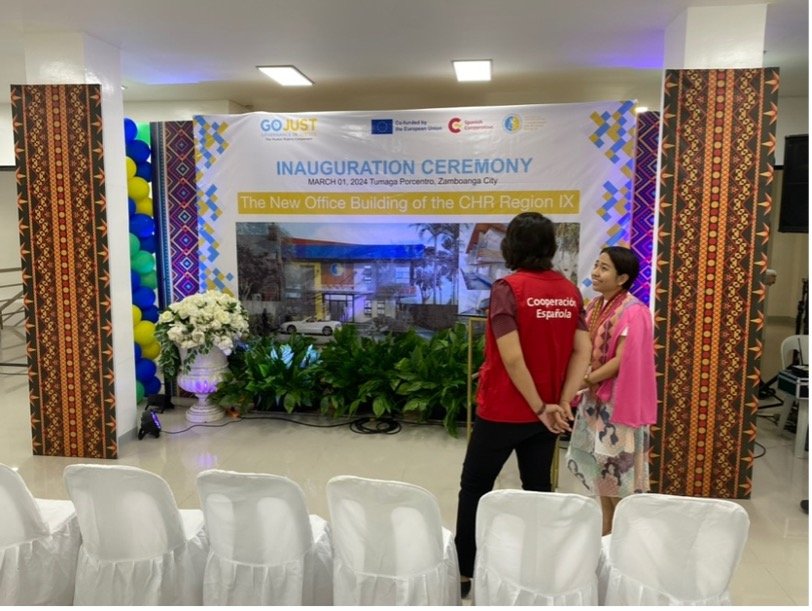
Almudena Villarino from the Spanish AECID and Princess Molleno of the CHR
Barter
Zamboanga City is known, among others, for its barter trade centers. Contrary to what you may assume, you don’t go into these markets exchanging 10 heads of cabbage for a head of goat. The “barter zone” was established in 1973 in Mindanao to facilitate trade among neighboring islands without tariff. The barter market is heaven for those who need their batik (Malay dyed cloth) fix and southeast Asian dish mix – from coffee to malong (long wraparound skirt), shawl to sotanghon (glass noodles), beads to sarong (short wraparound skirt. It is also a haven for travelers seasoned in the art of bargaining. You haggle and get hefty discounts from bulk-buying. But whatever you manage to buy, you won’t leave disappointed. The colorful and flavorful Malay products are all over the place. We left the barter center with eco-bags full of fabrics, treats, and goodies.
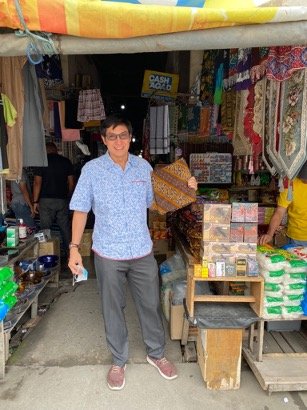
At Barter Center, Zamboanga City
The New CHR Building in Zamboanga
It was just rush-shopping, and by noontime we were at the inauguration site in Tomaga Porcentro, Zamboanga City. Already in the thick of summer, the sun’s rays tear through your skin and make you squint hard– a minor inconvenience we had to endure for the part of the ceremonies done outdoors. The customary speeches were delivered, first by CHR Chair Hon. Richard Palpal-latoc, followed by CHR IX Director Atty. Judelyn “Shobe” Macapili, European Ambassador Hon. Luc Véron, Spanish Ambassador Hon. Miguel Luis Utray Delgado, and Zamboanga City Mayor Hon. John Dalipe – all echoing gratitude for this mutually beneficial GOJUST II-HR project and affirming solidarity in the long term.

The GOJUST-II HR provides technical and physical support to the CHR.
Particularly affecting was Atty. Shobe Makapili’s narration of the challenges of not having their own office building – how they designated a corner for their “child-friendly room” that alternated as their mediation room; improvised a makeshift record office for their sensitive and confidential case documents; and sought out sundry spaces for their trainings because they lacked a conference room. Now with this new building, their “longtime dream” has “finally come to its fruition,” and with it comes their commitment to “render better, more prompt and more efficient public service.”
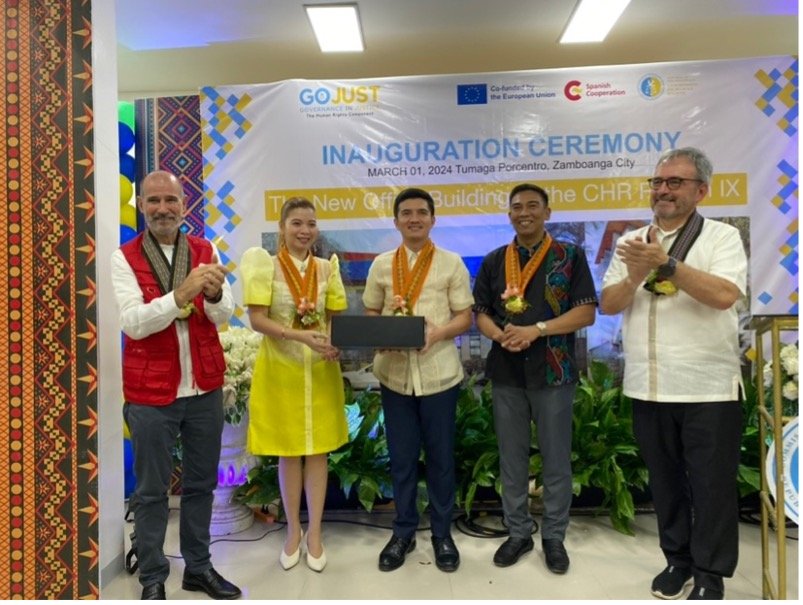
Spanish Ambassador HE Miguel Utray Delgado, CHR IX Director Atty. Shobe Macapili, Zamboanga City Mayor Hon. John Dalipe, CHR Chair Hon. Richard Palpal-latoc, and EU Ambassador HE Luc Véron
Atty. Shobe started working with the Commission in 2011, during the time of Chair Loretta Ann “Etta” Rosales. She was designated officer-in-charge Regional Director on March 7, 2020, “the same day that the country was put under lockdown,” which compelled them to shift to online work. After two years, she became the full-fledged CHR IX Director, with its tough challenges, particularly the need to serve such a diverse and expansive region – covering not only the Zamboanga peninsula (including Zamboanga del Sur, Zamboanga Sibugay, Zamboanga del Norte) but also the conflict-ridden BaSulTa areas (Basilan, Sulu, and Tawi-Tawi).
“To address their needs, we try to be creative through such activities as the Legal Clinic Caravan,” Shobe said. She also appreciates the rewards and recognition of service. “In 2021 and 2022, I was recognized as an Ally Change-maker for the LGBT community during the Pride celebration.”
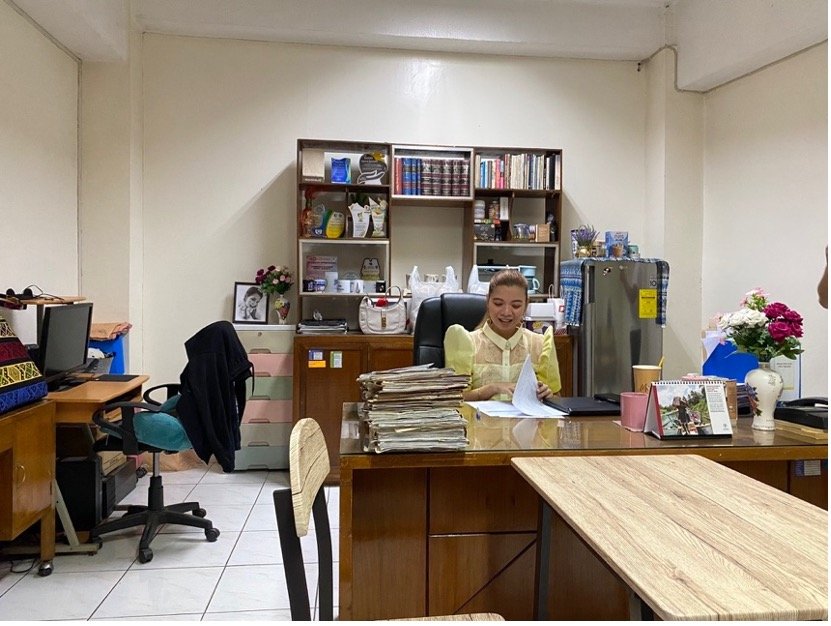
Atty. Shobe, CHR IX Director prepares to leave their current office for the new one.
Yakan Village
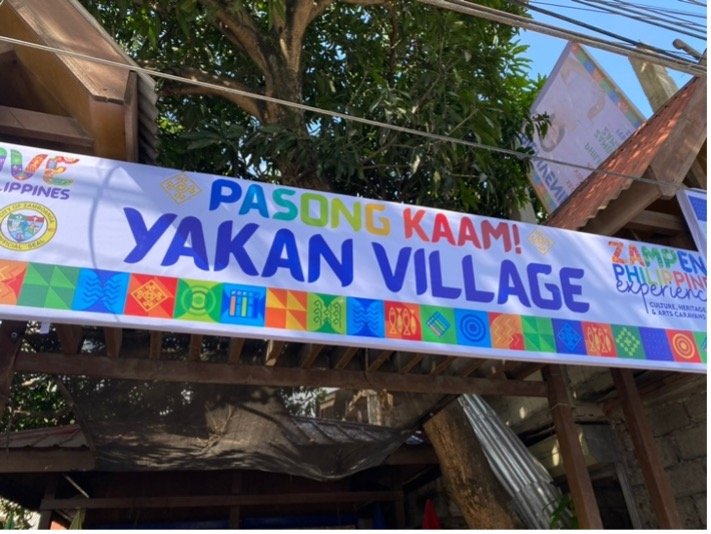
Yakan Village entrance
After the inauguration ceremonies, our group visited a center showcasing the hand-loomed fabrics of the Yakans, the indigenous Muslim settlers in Basilan – many of whom moved to Zamboanga City and other places in Mindanao due to political strife. At this place you will notice the contrast from the previous trade center we visited. The barter markets offer an explosion of beautiful, colorful products that are nevertheless mass-produced. At the Yakan Village, each product is carefully, slowly, lovingly crafted. Every piece is an artisan’s masterwork. The woman weaver, busy in front of her loom, was friendly enough to indulge me in small talk as she threaded the strings and produced unique patterns, as if in a dream. “We finish one meter in four to five days,” she said.

Yakan weaver
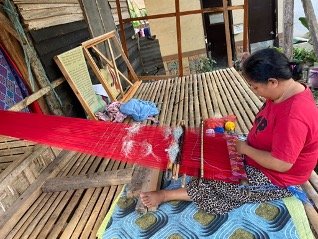
Each pattern is unique.
I was also shown the so-called seputangan, a square cloth with a much more intricate design that requires a longer time and a high level of skill to make. It also fetches a much higher price.
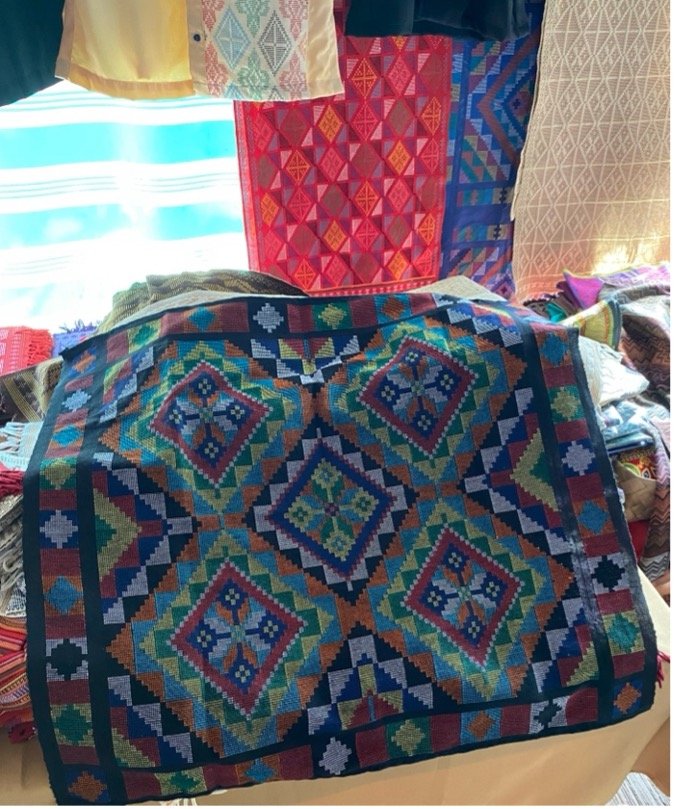
The seputangan
The seputangan was beautiful and tempting, but I was a fascinated traveler with a limited budget, so I bought a much simpler table runner (which takes three days on average to make) with matching coasters.
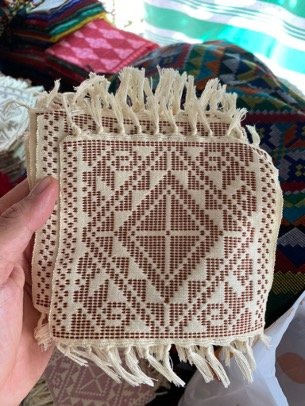
Yakan coasters
After our brief immersion in the rich Yakan heritage and humble contribution to the local economy, my companions left for their flight back to Manila. I, meanwhile, had one additional day to see a bit more of the peninsula – such as a beach known for its unique hue.
The Pink Beach
I was picked up by the friendly CHR IX staff at 7:00 the following Saturday morning. I am not exactly a morning person and would have wanted to sleep more given that I was still nursing a fever with some cough. But I convinced myself that swimming in salty sea water could do my sore throat some good. I wasn’t wrong. I did get better eventually, though the meds might have contributed too.

Paseo del Mar
The Pink Beach is located in the Great Sta. Cruz Island off the southwestern coast of Zamboanga City. The jump-off point is Paseo del Mar, a seafront parkway with manicured lawns and restaurants and bars that get even more lively at night. The Paseo is close to the equally well-known Fort Pilar, a Spanish military fortress built in the 17th century that was converted into a museum in recent times.
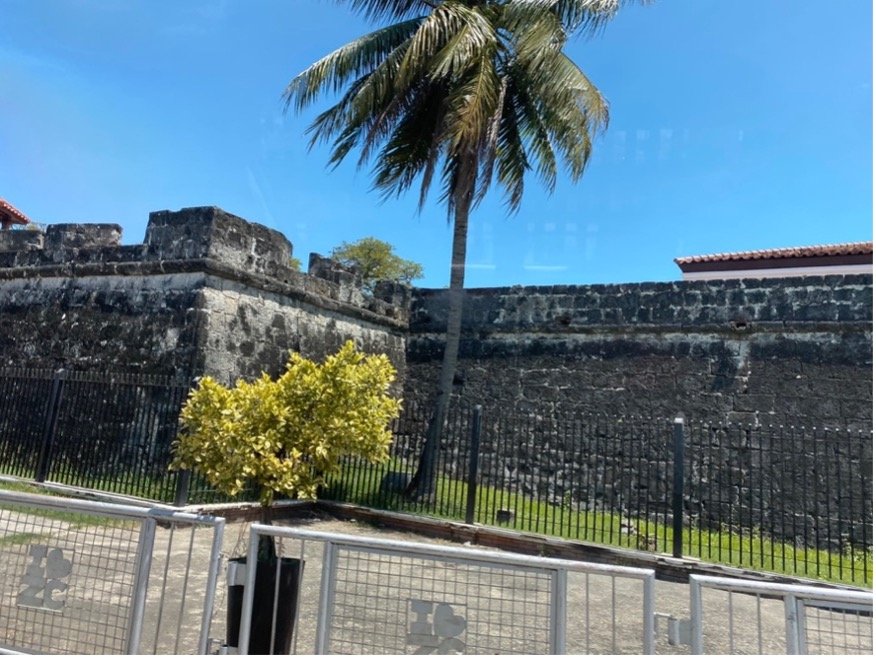
Fort Pilar
The briefing prior to the 15-minute boat ride to Sta. Cruz was useful and insightful. The guide enumerated certain no-no’s at the site: crossing the boundaries, vandalism, bringing home sand, and bringing in single-use plastic (or if you really need those plastic items, you cannot leave them there). The last part was particularly welcome for me, as I’ve seen so many beautiful beaches ruined by plastic pieces on sand, floating, or otherwise strewn about. The guide then emphasized how serious their policies are by collecting our plastic stuff.
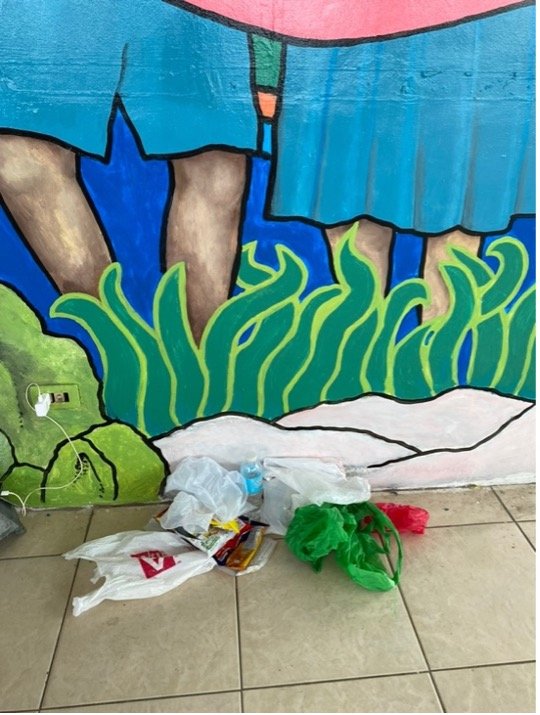
Plastic items collected prior to going to Sta. Cruz Island
After paying the transportation fee of PHP 1,000 ($18) per person, we waited our turn as we gazed at the destination island four kilometers away, separated from us by the Basilan Strait. In a few minutes, we hopped on our boat, donned the obligatory life-vests, and headed to the island with the uniquely colored sandy beach.
“The colorful and flavorful Malay products are all over the place. We left the barter center with eco-bags full of fabrics, treats, and goodies”
Strictly speaking, it was not exactly pink. The beach was mostly white sand with dots of pink – which are in fact crushed organ pipe corals. I understand that, some time ago, there were more of these gorgeous pink and orange corals around the island and that the beach displayed a much stronger shade of pink. Nevertheless, the place is still wonderfully preserved. Apart from the plastic ban, there were other regulatory guidelines: guests are not allowed to stay overnight (the last boat back to the mainland leaves at 2:00 p.m.) and huge, concrete structures are not built on the island. I gathered later that its loose sandy base could not support such kinds of infrastructure anyway.

Organ pipe corals responsible for the beach’s pink hue
Good thing they did not ban swimming, for what else could be the point? I don’t go to beaches for sight-seeing and picture-taking alone. After settling in our hut, we immediately sampled the calm, crystalline waters. But one is advised not to venture far out into the open sea. Unlike the much more famous (but overly commercialized) Boracay beach, which remains shallow and safe for a long stretch, the Pink Beach goes to a sudden plunge. It actually gets quite creepy when you swim underwater and peer into the dark depths. Furthermore, the weather sometimes changes quickly and, when it seems to be getting particularly bad, all guests need to quickly prepare to head back to the safety of the city.
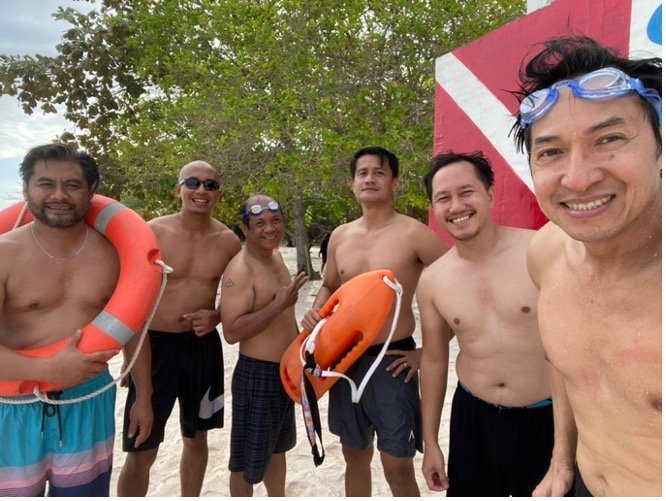
The author (right) with the CHR IX staff
With our physical exertion on water and the scrumptious seafood on display, understandably we got hungry early. By 10:00 a.m. we were ready for lunch! Pompano, grilled squid, lato (fresh seaweed), and seashells locally called bagumon – all eaten with bare hand with rice, tomatoes, onions, calamansi (native citrus), and soy sauce. All exuding that delectable picnic vibe, except for the Jollibee fried chicken mixed in, which somehow seemed out of place in that spread. In a matter of minutes, we gained back the calories we expended. By noontime, having satisfied a beach fix and a curiosity, we headed back to the city.
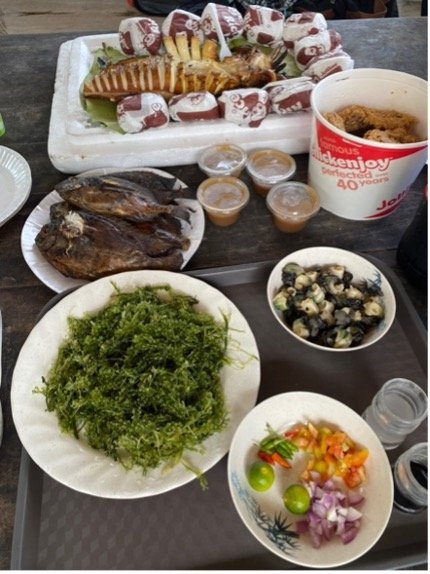
Seafood galore and then some
The foray into the pinkish beach was short and sweet, but I could readily say it was a half-day very well spent. The same goes for the rest of this Zamboanga zip. By mid-afternoon I was back at the airport, sporting a bit of a sunburn, sore muscles from the swim, and what remained of the sore throat. Nothing could end the trip better than a good old deep-tissue massage. What do you know? At times, you do get the things you wish for.
Shukran!
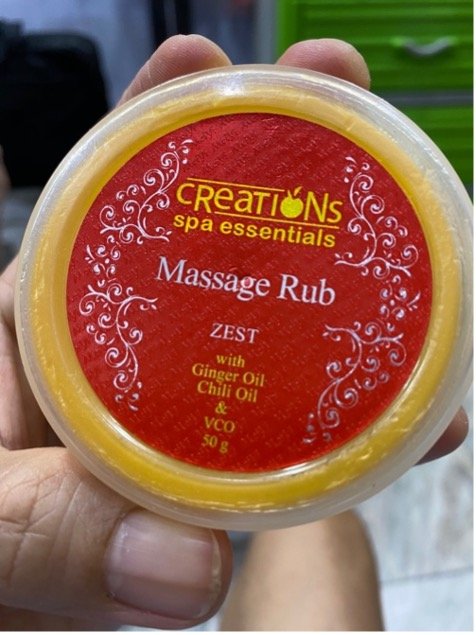
A soothing massage concludes the trip.

Bobby Garcia is the author of To Suffer thy Comrades: How the Revolution Decimated its Own. He was Undersecretary at the Office of the Political Adviser for President Benigno S. Aquino, Jr. – under whose term the Philippines filed the WPS territorial claim with the Permanent Court of Arbitration. He presently leads the Technical Assistance Team of Governance in Justice (GOJUST) II – Human Rights, supporting the Commission on Human Rights (CHR) through funds from the European Union (EU) and the Agency for International Development Cooperation (AECID) of Spain.
More articles from Bobby Garcia







No comments:
Post a Comment